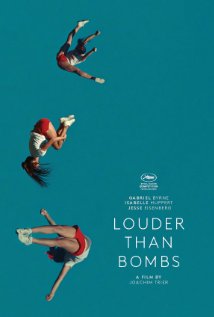AS WELL AS ANTONIONI & RESNAIS - STILL HAS "ONE FOOT IN THAT KIND OF FORMALISM"
 An interesting excerpt from an Cannes 2015 interview with Louder Than Bombs director Joachim Trier, posted yesterday by The Upcoming's Christian Herschmann:
An interesting excerpt from an Cannes 2015 interview with Louder Than Bombs director Joachim Trier, posted yesterday by The Upcoming's Christian Herschmann:Herschmann: How did the diary of Conrad, Isabelle’s youngest son, take shape – a multilayered compilation of a young boy’s mindset and perception?Trier: We had to write it and then write it again and again and again during editing; it was like making a feature film, that diary. We have many versions of it and I’m very happy with the one we used. We even have the clip from Opera by Dario Argento in it. One of our producers is Italian and knows Dario Argento and we got that through him. We wanted to get different elements of different cultural expressions into the diary. We tried to find poetry in the truth of the character. I love the film Kes by Ken Loach. My favourite moment in that film – the one where I always cry – is when the kid, who doesn’t know how to express himself, is suddenly asked by his teacher to talk for the first time and tell them how he takes care of his bird – he knows the boy is with this bird all day. And the kid speaks for the first time and talks freely about who he is. That’s not exactly what we’re doing, but I wanted Conrad’s diary to be a revelation of the discrepancy between his social inability and his inner life, which is so rich.
It is not only a written text in the film, but presented in a very visual way, as a montage of imagery. You used a similar technique in Oslo, August 31st and they both work very well. How did you become interested in this form of expression?
I went to the National Film and Television School in London, we called it National Social Realist Film and TV School. Steven Frears was a teacher there and Mike Leigh, people that I now admire tremendously for their skills in drama, but at the time I was really into Antonioni, Alain Resnais and Brian De Palma. I wanted montage and the break of the image and the form to be really at the essence of what I did, and I think I changed. Also by going to that school, I discovered Ken Loach and the fact that, in the middle of social realism, there is poetry and truth and not only social commentary hitting you on the head. In the best of these films there’s something more that transcends. However, I still have one foot in that kind of formalism. Showing thought patterns in cinema through montage I find very interesting. And it’s been appropriated by commercials, but I always try to show that it could be more expressive and, ideally, more complex.
What do you mean by thought patterns?
The train of thought. How people think. The structuring of thought, which I think is the temporal experience of images on the screen. We always talk about stories, because it’s a literary term and it’s very easy to say, but the fact is we’re watching images in time and they either correlate or don’t with our sensomotoric thought patterns. And it sounds very technical, but I feel it’s a fact, you’re actually dealing with theme and image when you make a movie, all the time. It can be quick or slow: how do you pace the information? Is it possible to express, to show thinking literally, the association chain of a young boy thinking randomly about his life? Yeah, let’s try. That’s what I mean with thought pattern.
There are a lot of memories in the film, a lot of dreams…
That’s what we constitute our identity on, these frail things that we believe are truths about ourselves and that’s very scary and also liberating. AndI feel the film is very much about that: the questioning of identities.



